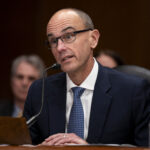What’s next? That’s a question that we’ve asked many times throughout our careers. And despite having 50-plus years of collective experience between us, it’s not one that we intend to stop asking anytime soon. In fact, for the sake of the insurance industry, we encourage more people—especially our female colleagues—to do the same.
Executive Summary
Experienced insurance professionals seeking new challenges may provide opportunity to stave off the talent deficiency and even boost leadership diversity, allowing more women to step into executive roles, say two executives working through their “second acts.” Here, they also give tips for other Act II performers embarking on similar journeys.As the retirement age continues to increase, many experienced professionals are not looking at the stereotypical retirement anytime soon. Instead, we are looking ahead to another 10, 15 or even 20 years of productive, profitable employment—the “second act” of our careers, as many call it.
Switching It Up
According to a recent report from the American Institute for Economic Research (AIER), many of those with 25-plus years in the workforce are very successful in finding new careers. In a recent AIER survey of 2,000 people (“New Careers for Older Workers,” April 2015), 82 percent of people 47 and older who tried to transition to new careers in the last two years were successful. In some cases, workers remained at the same company but in a new role. For others, they changed where they worked, their occupation or their field. Nearly 70 percent of successful changers saw their pay either stay the same (18 percent) or increase (50 percent), while 31 percent took a pay cut.
Such success will only breed more success, especially as the number of seasoned and more experienced workers is growing. More than 40 percent of people 55 and older participated in the labor force in 2014, up from just 29 percent in 1993, according to the Bureau of Labor Statistics. These experienced workers are in a unique position, having ample work experience and looking for the right opportunity—whether a new career challenge or an entirely new career.
People 55 and older represented more than 21 percent of the labor force in 2014—a figure projected to increase to nearly 25 percent in 2024, according to the Bureau of Labor Statistics. Perhaps more telling is the fact that the average annual growth rate of the 55-years-and-older group is projected to come in at more than three times the rate of growth of the overall labor force over the next decade.
The experienced workers in this group are in a unique position, having ample work experience and looking for the right opportunity—a new career challenge or an entirely new career.
For some, a “second act” career may be a financial choice to continue working doing what they’ve been doing in their careers for the last couple of decades. For others, it’s an opportunity to push the envelope a bit as they arrive at a place in their lives where they are not as hindered by family responsibilities or financial obligations. Women especially may find that during the latter half of their careers they have more leeway to make choices based on what they really want to get out of their careers.
While many of us did not put our careers totally on hold to raise families, we may have held back a bit to juggle our multiple responsibilities. We may have hesitated to seek a promotion, transfer to a new location or switch employers to accommodate other demands. We didn’t want to take our children out of their current school system. We needed to stick closer to home to take care of aging parents. We juggled significant personal responsibilities with work responsibilities.
At some point, however, personal responsibilities change—our work-life balance becomes less of a balancing act—and then we find ourselves open to more challenging opportunities.
If this description sounds like you, ask yourself, “What’s going to hold you back now?”
Our answer, “Nothing!”
The Next Half
Writer and feminist Betty Friedan once said, “Aging is not lost youth but a new stage of opportunity and strength.”As women, we do have a bias. We think women entering the second halves of their careers can make tremendous contributions to our industry. For many women, second acts often are an opportune time—perhaps the best time during their career—to make a big move.
As in any time during a career, if we are ready to make a move, we are the ones who have to make it. We do it by:
• Taking a risk. Women have a reputation for not taking risks. Personally, we’ve caught ourselves being risk averse, turning down a new assignment before rethinking it and saying, “Why not me?” Sometimes we need to remind ourselves to just do it.
• Showing confidence in our abilities. Whether they’re qualified for them or not, men look for challenging assignments and actively lobby for them, not letting self-doubt get in the way. Women think they need to be 100 percent prepared before they try something new. Especially if you’re looking for a second act career opportunity, exude confidence that should accompany 20 or 30 years of work experience.
• Articulating what we want.Don’t let the desire to change be hampered by misconceptions. Many women are overlooked because of preconceived notions—the belief that they don’t want an opportunity because of relocation or more travel, for example. A September 2015 Gallup poll found that 12 percent of women say they have been passed over for a promotion or other opportunity because of their gender at some point in their life.
• Advocating for ourselves.When new opportunities arise, it’s up to us to set the record straight. We need to know what we want and not shy away from asking for it, openly and honestly.
• Exercising personal flexibility. Earlier in our careers we may have had things tie us down. Often these hurdles don’t exist in the latter half of our career, giving us more opportunity for a broader range of possibilities. It’s difficult to go very far if you aren’t flexible. Be open to new ideas and new ways of doing things.
• Networking.The power of a support system can make an incredible difference. As we were writing this article, Facebook COO Sheryl Sandberg posted her 2016 resolution on the social networking site, sharing her struggles after losing her husband this year and how her “Lean In” circle—friends and colleagues she’s known forever—helped her through. She expressed her belief in the strength of human connection and how it can empower people, particularly women, to move forward, believe in themselves and follow their dreams.
The Insurance Industry’s ‘Second Act’ Opportunity
Given the considerable discussions in our industry about the looming talent shortage, colleagues who are looking for a change or a new challenge during their second acts may very well provide opportunity to stave off the talent deficiency and perhaps even boost our leadership diversity, allowing more women to step into such roles. If we are going to continue working, why shouldn’t it be here, in the insurance industry?
Especially as we look to solve risks for new industries or delve into more complex problems—from cyber risks to microinsurance to global warming—we need to consider how we can harness an experienced workforce and all that it has to offer. Some carriers are already recruiting professionals with Internet and technology experience to help address growing concerns posed by cyber risks.
Others are also trying to harness this wise and tested workforce for their wisdom, knowledge and judgment. Harvard University’s Advanced Leadership Initiative is designed for experienced professionals who want to tackle society’s big problems: poverty, global health, education and the environment. Most of the fellows in the program are in their 50s and 60s and include former chief executives, foundation presidents, top attorneys and high-ranking government officials. Stanford University has a similar program in its Distinguished Careers Institute.
The U.S. Bureau of Labor Statistics estimates more than 150,000 new jobs within the insurance industry by 2024. The average age of an insurance professional is 45 years old, and only 5 percent of students within the millennial generation describe themselves as “very interested” in working in the industry, according to a 2012 study from the Griffith Insurance Education Foundation.
We need a more concerted effort to not only enlist the new energy and skills of future generations but take advantage of our existing, highly experienced workforce. For many women, the opportunity to assume added leadership responsibilities or step up to stimulating new assignments presents itself a decade or two into their careers. There really is no rule imposing time limits on when we can push our career goals forward. The only limitations that we have are the ones we put on ourselves.
As an industry, we can do more to encourage our experienced, long-tenured colleagues to keep developing their skills and stretching their capabilities. Whether through existing mentorships, establishing women’s leadership networks or mirroring advanced executive initiatives like those established at Harvard and Stanford, we can reap the decades of knowledge that our industry has—and perhaps attract seasoned professionals from other industries who are looking for their second acts to begin.
There’s a talent crisis looming in our industry. We know it. We keep telling ourselves how “old” this industry’s workforce is getting. We certainly do need to attract young talent, but we can’t run the risk of letting our best, most experienced assets walk out the door. Experience really does matter. How we channel and make use of our workforce’s decades of experience could make all the difference in this industry for decades to come.





















 Executives on the Move at HSB, American Modern Insurance Group, AIG
Executives on the Move at HSB, American Modern Insurance Group, AIG  McKinsey Plots Thousands of Job Cuts in Slowdown for Consulting Industry
McKinsey Plots Thousands of Job Cuts in Slowdown for Consulting Industry  What to Expect in 2026: U.S. P/C Results More Like 2024
What to Expect in 2026: U.S. P/C Results More Like 2024  Rebuilding Negotiation Talent: Why This Skill Is Missing and How to Fix It
Rebuilding Negotiation Talent: Why This Skill Is Missing and How to Fix It 








